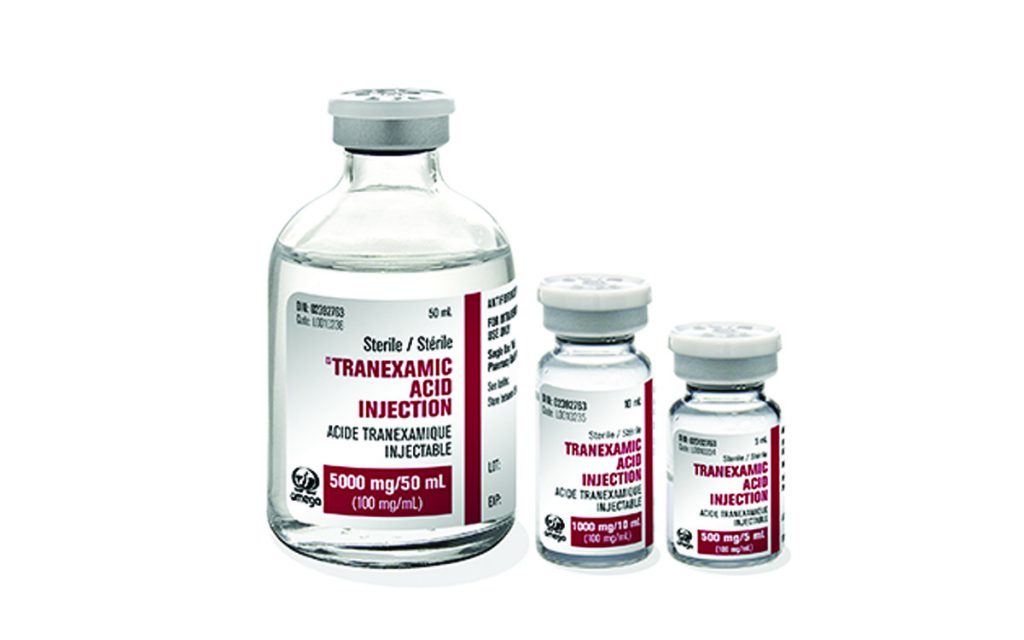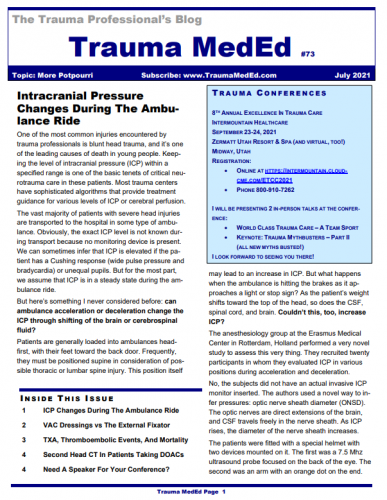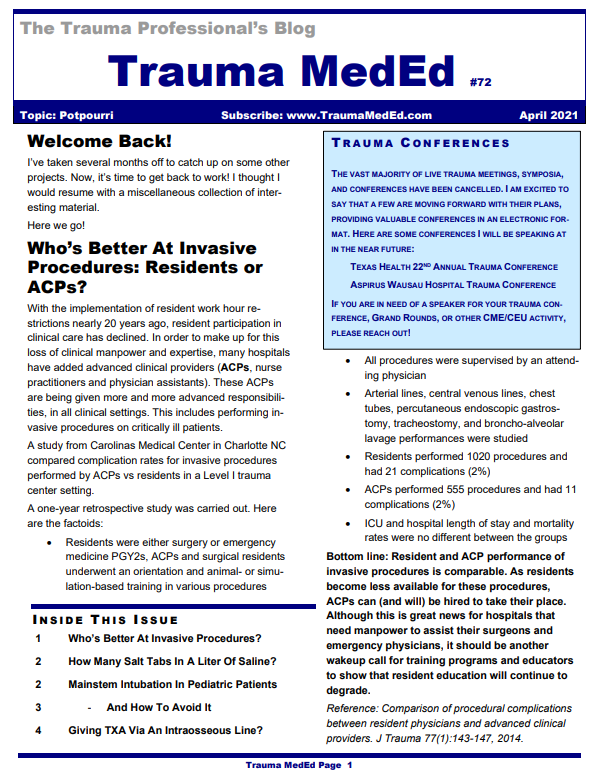The world is divided into trauma centers that are TXA believers and those that are TXA nonbelievers. It all depends on how one interprets the CRASH-2 data and subsequent studies. Then came CRASH-3 with TXA use for patients with TBI. This large study found improved survival in patients with mild to moderate head injury when given “early.”
The group at Oregon Health Science University tried to better define this concept of “early.” They examined early vs later administration of TXA in patients with moderate to severe TBI. Note that this degree of head injury is a bit different than CRASH-3 (mild to moderate in CRASH-3 and moderate to severe in this one). This was a multicenter trial that included patients with GCS < 12 and who were hypotensive with SBP < 90. Patients received either a 1g bolus followed by a 1g infusion over 8 hours, or a 2 g bolus only. The authors subdivided these patients into early administration (<45 minutes after injury) or late (45 minutes to 2 hours after injury).
Here are the factoids:
- There were 354 patients in the early administration group and 259 in the late group
- All outcomes, including 1 month and 6 month mortality and the extended Glasgow outcome scale were not significantly different between early and late groups (exact numbers were not given)
- There was no difference in secondary complications between the groups (again, exact numbers or complication types were not given)
The authors concluded that there was no difference in outcomes in early vs later administration of TXA in these head injured patients. They suggest that patients can be given TXA anytime within two hours without loss of benefit.
Bottom line: Essentially, this ends up as a noninferiority study. The biggest question with this type of study is, do you have enough subjects to detect a significant difference? Taken to an extreme, let’s say you have 5 patients who receive a drug who are compared to 5 who did not for some mystery condition. Three who did not get the drug die (60% mortality), but only two who get it do (40% mortality). In relative terms, there was 33% decrease in mortality with the drug. But in absolute terms, it was one patient. Would anyone see this as a significant result with such small numbers?
But now multiply by a thousand, and 300 die without the drug and only 200 die who were given it. The relative difference is the same, but the absolute difference is beginning to look large and significant.
So the smaller study won’t meet the test of significance but the larger one will. The key question in the TXA study here is, do they have enough patients enrolled to show there is no real difference between the groups? I love doing back of the napkin power analyses, and I admit I certainly don’t have all the numbers and probabilities needed for a precise calculation. But the groups sizes in this study (354 vs 259) seem a bit small to achieve significance unless there are large disparities in outcomes.
I certainly recognize that it’s just not possible to put all the relevant information for a research project into a four paragraph abstract. One would need to be able to submit 12 slide PowerPoint decks. So I’m sure more info will be available as I take in the presentation next Friday.
Here are my questions for the authors and presenter:
- The study is nicely designed as a randomized, double-blind trial, but how did you blind one vs two doses? Did everyone get an infusion of something, TXA vs saline?
- Why did you select 45 minutes as the cutoff for early vs late administration? Was this arbitrary or is it based some data?
- Show us the power analysis that demonstrates the total number of patients in the study is sufficient to show us true non-significance in your results.
- And I’m sure you will show the actual survival and complications numbers (and type) in the presentation, since they were not available in the abstract.
Reference: THE EFFECTS OF TIMING OF PREHOSPITAL TRANEXAMIC ACID ON OUTCOMES AFTER TRAUMATIC BRAIN INJURY. EAST 35th ASA, oral abstract #40.



